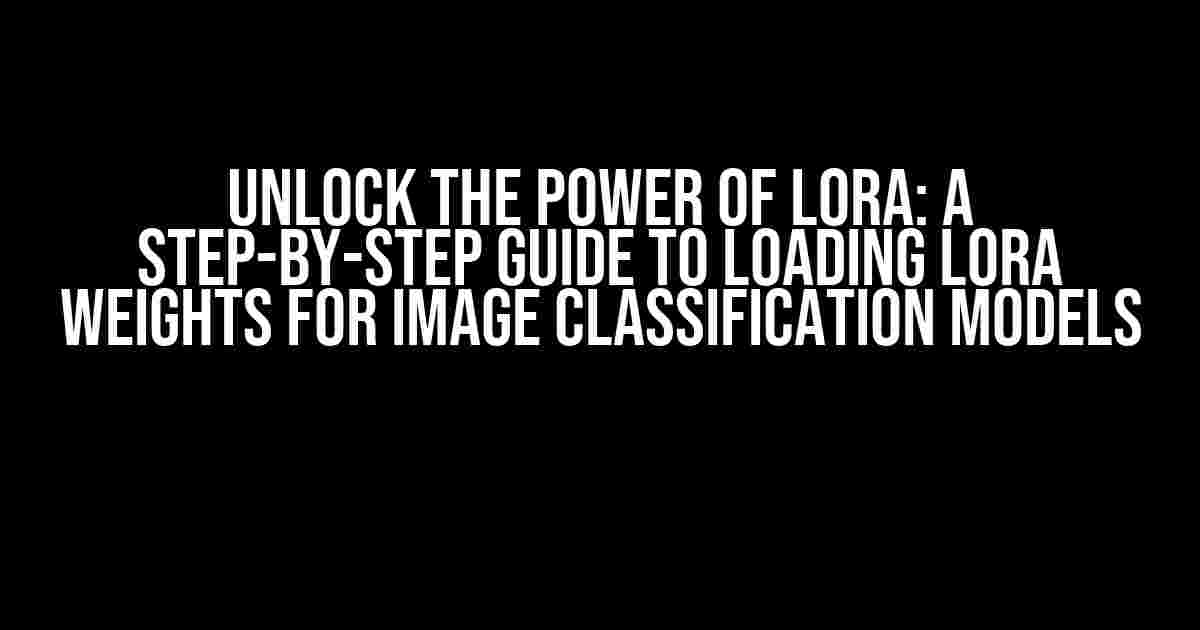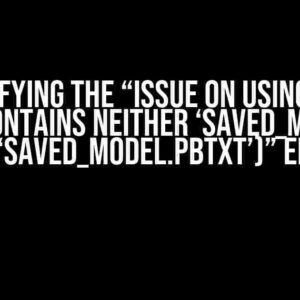Are you struggling to load LoRA weights for your image classification model? Look no further! In this comprehensive guide, we’ll take you on a journey to unlock the full potential of LoRA, a powerful technique for model adaptation. By the end of this article, you’ll be equipped with the knowledge to seamlessly load LoRA weights and boost your model’s performance.
What is LoRA?
LoRA (Learning to Refine Adapters) is a novel approach to adapting pre-trained models to new tasks or domains. It involves learning a set of adapter weights that refine the pre-trained model’s knowledge to tackle specific challenges. LoRA has gained popularity in recent years due to its ability to fine-tune models without requiring extensive labeled data or computational resources.
Why Load LoRA Weights?
Loading LoRA weights is essential for leveraging the power of LoRA in your image classification model. By loading pre-trained LoRA weights, you can:
- Adapt your model to new tasks or domains with minimal additional training data
- Improve your model’s performance on niche datasets or tasks
- Reduce the computational resources required for fine-tuning
Prerequisites
Before we dive into the nitty-gritty of loading LoRA weights, make sure you have the following:
- A pre-trained image classification model (e.g., ResNet, VGG, etc.)
- A compatible framework for loading LoRA weights (e.g., PyTorch, TensorFlow, etc.)
- A dataset for fine-tuning your model
Loading LoRA Weights: A Step-by-Step Guide
Now that we’ve covered the basics, let’s get started with loading LoRA weights! Follow these steps to load LoRA weights for your image classification model:
Step 1: Install the Required Libraries
pip install transformers
pip install torch
In this example, we’ll use the PyTorch framework and the Hugging Face Transformers library to load LoRA weights.
Step 2: Import the Necessary Modules
import torch
from transformers import LoRA, VisionTransformer
We’ll import the LoRA module from the Hugging Face library and the VisionTransformer module for our image classification model.
Step 3: Load the Pre-Trained Model
model = VisionTransformer('vit-base-patch16-224')
In this example, we’ll load a pre-trained VisionTransformer model with the ‘vit-base-patch16-224’ architecture.
Step 4: Initialize the LoRA Adapter
lora_adapter = LoRA('lora-vit-base-patch16-224', model=model)
We’ll initialize the LoRA adapter with the ‘lora-vit-base-patch16-224’ architecture and pass our pre-trained model as an argument.
Step 5: Load the LoRA Weights
lora_weights = torch.load('lora_weights.pth')
lora_adapter.load_state_dict(lora_weights)
We’ll load the pre-trained LoRA weights from a file (e.g., ‘lora_weights.pth’) and use the `load_state_dict` method to load the weights into our LoRA adapter.
Step 6: Fine-Tune Your Model
criterion = torch.nn.CrossEntropyLoss()
optimizer = torch.optim.Adam(model.parameters(), lr=1e-5)
for epoch in range(5):
for batch in dataset:
inputs, labels = batch
optimizer.zero_grad()
outputs = model(inputs)
loss = criterion(outputs, labels)
loss.backward()
optimizer.step()
In this example, we’ll fine-tune our model using the Adam optimizer and cross-entropy loss function. We’ll iterate through our dataset for 5 epochs, updating the model parameters after each batch.
Tips and Tricks
To get the most out of LoRA, keep the following tips and tricks in mind:
- Use a compatible framework: Make sure the framework you’re using is compatible with LoRA weights.
- Choose the right adapter architecture: Select an adapter architecture that matches your pre-trained model and task requirements.
- Monitor your model’s performance: Keep an eye on your model’s performance during fine-tuning and adjust the hyperparameters as needed.
- Experiment with different LoRA weights: Try loading different LoRA weights to find the best adapter for your task.
Conclusion
With these step-by-step instructions, you’re now well-equipped to load LoRA weights for your image classification model. Remember to fine-tune your model and monitor its performance to unlock the full potential of LoRA. Happy adapting!
| Framework | Adapter Architecture | Pre-Trained Model |
|---|---|---|
| PyTorch | LoRA | VisionTransformer |
| TensorFlow | AdapterHub | ResNet |
In this article, we’ve covered the basics of LoRA and provided a comprehensive guide to loading LoRA weights for image classification models. Whether you’re using PyTorch or TensorFlow, we hope this article has been informative and helpful. Happy learning!
Frequently Asked Question
Loading LoRA weights for an image classification model can be a bit tricky, but don’t worry, we’ve got you covered! Here are some frequently asked questions to help you navigate the process:
What is LoRA and why do I need it for image classification?
LoRA (Low-Rank Adaptation) is a technique for fine-tuning pre-trained models on new datasets or tasks. When it comes to image classification, LoRA allows you to adapt a pre-trained model to your specific dataset or task with minimal computational resources and memory requirements. By loading LoRA weights, you can leverage the knowledge learned from a large dataset and adapt it to your specific use case, resulting in improved performance and accuracy.
How do I load LoRA weights into my image classification model?
To load LoRA weights, you’ll need to use a deep learning framework like PyTorch or TensorFlow. Here’s a high-level overview of the process: 1) Load the pre-trained model and its weights, 2) Load the LoRA weights for your specific dataset or task, 3) Merge the LoRA weights with the pre-trained model weights, and 4) Fine-tune the model on your dataset using the merged weights.
What are the benefits of using LoRA for image classification?
Using LoRA for image classification offers several benefits, including: 1) Improved performance and accuracy on your specific dataset or task, 2) Reduced computational resources and memory requirements, 3) Faster fine-tuning times compared to training from scratch, and 4) The ability to adapt pre-trained models to your specific use case, reducing the need for extensive retraining or data collection.
Can I use LoRA with any pre-trained image classification model?
Technically, yes! LoRA can be used with any pre-trained image classification model. However, the performance and accuracy improvements will vary depending on the model architecture, the quality of the pre-trained weights, and the similarity between the pre-trained dataset and your specific dataset or task. For best results, choose a pre-trained model with a similar architecture and dataset to your specific use case.
Are there any limitations or challenges associated with using LoRA for image classification?
While LoRA offers many benefits, there are some limitations and challenges to be aware of. These include: 1) The requirement for high-quality pre-trained weights, 2) The need for a sufficient number of training samples for fine-tuning, 3) The potential for overfitting if the LoRA weights are not properly merged, and 4) The need for careful hyperparameter tuning for optimal performance.


